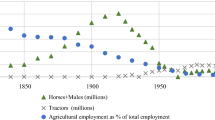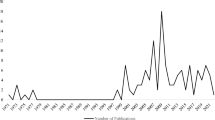Abstract
This paper studies the efficiency of land taxation in a system of jurisdictions with absentee ownership of land. The government of a jurisdiction exploits absentee owners and overtaxes land. Hence, even if land taxation does not distort the use of land, it distorts the allocation of resources between the private and public goods, creating an efficiency loss. If individuals choose their land ownership by trading it in the asset market, they do not necessarily choose an efficient ownership. The government of a jurisdiction also imposes an absentee owner surcharge, reducing the return to absentee ownership and eliminating absentee ownership. Surcharges thus improve the efficiency of land taxation in the long run.
Similar content being viewed by others
Notes
Why Henry George had a point. The Economist, April 2, 2015, available at https://www.economist.com/free-exchange/2015/04/01/why-henry-george-had-a-point [accessed June 26, 2018].
Tax Policy Center, Urban Institute and Brookings Institution, 2016, Local Property Taxes as a Percentage of Local Tax Revenue 1977–2014, available at http://www.taxpolicycenter.org/statistics/local-property-taxes-percentage-local-tax-revenue [accessed September 20, 2017].
Easy Guide to Utah Real Estate Taxes. Park City Real Estate Guide, February 5, 2008, available at http://blog.parkcityrealestateguide.com/how-to-estimate-your-utah-real-estate-taxes/ [accessed September 20, 2017].
New York Considers Special Property Surcharge for Nonresidents. Tax Foundation, September 26, 2014, available at http://taxfoundation.org/blog/new-york-considers-special-property-surcharge-nonresidents/ [accessed September 20, 2017].
Due to the linear homogeneous production function, the number of firms is of no consequence, and a jurisdiction is assumed to have one firm or one production function, the standard approach in the literature.
This way, the production function can incorporate residential buildings, namely houses, although the focus is on nonresidential land/properties. That is, treating a house as land in the production function, an owner of a house earns rents from the house (imputed rents for an owner-occupier and market rents for an absentee owner).
Land ownership will be endogenized later.
The taxes that maximize the social welfare W are second-best efficient, as lump-sum taxes are not available.
More formally, the choice of \(\tau _i\) by the government of jurisdiction i satisfies the FOC, \(\partial Q_i/\partial \tau _i = U_i^z m_i - U_i^x \theta _{ii}^o m_i - \mu _i u_i' \theta _{ji}^o m_i = 0.\) Dropping \(m_i\) and using \(\theta _{ii}^o = 1 - \theta _{ji}^o\), the FOC can be rewritten as \(U_i^z - U_i^x + (U_i^x - \mu _i u_i')\theta _{ji}^o = 0.\) Since the public good is provided at the efficient level when \(U_i^z - U_i^x = 0\), it is overprovided (underprovided) if \(\mu _i < (>)\;U_i^x/u_i'.\)
An exception to this known result appears that when wages are uncertain, a proportional wage tax is still used in the presence of lump-sum taxation, as the wage tax serves as insurance while the lump-sum tax does not (for example, Eaton and Rosen 1980a, b). However, there is no uncertainty in the present model, yet lump-sum taxation does not obviate the need for distortionary land taxation. Another exception is that the government of a jurisdiction sets the business property tax at a positive rate and has a lump-sum tax that can be zero, positive or negative when a lump-sum tax, a business property tax and a source-based wage tax are available and when business land of a jurisdiction is partially owned by nonresidents (Braid 2005).
That is, some jurisdictions have recently imposed surcharges but have not changed land taxes, and the land tax \(\tau \) is treated as a parameter in this section.
The approach here follows the standard capital asset pricing models (for example, Fama and Miller 1972), except that the public good is included.
The second-period utility is not discounted for simplicity, but it has no effect on the results below.
The choice variables, \((b_i^*, \theta _{ii}^*, \theta _{ij}^*),\) are functions of the taxes \((\tau _i, s_i, \tau _j, s_j)\), but the effects of the taxes on those choice variables can be ignored due to envelope results. However, the effect of the taxes on \(b_i^*\), namely \(\partial b_i^*/\partial \tau _i\), is included in the FOC (29) in order to compare FOC (29) to another FOC below.
Suppose that a resident of jurisdiction i trades her land ownership in the asset market but still holds land in jurisdiction j, for example, due to attachment to a particular parcel of land (Needham and de Kam 2004; Hong 2007). Jurisdiction j then would impose a surcharge as much as possible. However, such a surcharge is inefficient, as noted earlier.
According to the analysis in the previous section, it is clear that \(\theta _{ii}^{**}= 1, \theta _{ij}^{**} = 0\) and \(s_i^{**}\) = indeterminate.
Absentee owners typically own a second home in a foreign jurisdiction, and the taxation of a second home is an interesting topic and can be analyzed in the property tax framework. However, this topic is beyond the scope of this paper and left for future research.
With a large number of jurisdictions (Wilson 1986; Zodrow and Mieszkowski 1986), each jurisdiction takes \(\rho \) as given, so \(\mathrm{d} \rho /\mathrm{d} \tau _i = 0\) and hence \(\partial k_i/\partial \tau _i = 1/f_i^{kk} < 0\). These changes in (32) do not alter the results, and (35) continues to hold.
To simplify notations, endowment superscript o in \(\theta _{ii}, \theta _{ij}\) and \(\phi _i\) is omitted.
While jurisdictional subscripts are omitted at a symmetric equilibrium, they are kept in \(\partial k_i/\partial \tau _i\) to keep tract of the sign of the derivative correctly, given that \(\partial k_i/\partial \tau _i\) and \(\partial k_j/\partial \tau _i\) have opposite signs.
References
Arnott R, Grieson RE (1981) Optimal fiscal policy for a state or local government. J Urban Econ 9(1):23–48
Atkinson AB, Stiglitz JE (2015) Lectures on public economics. Princeton University Press, Princeton
Beck JH (1983) Tax competition, uniform assessment, and the benefit principle. J Urban Econ 13(2):127–146
Bentick BL (1979) The impact of taxation and valuation practices on the timing and efficiency of land use. J Polit Econ 87:859–868
Braid RM (1993) Spatial competition between jurisdictions which tax perfectly competitive retail (or production) centers. J Urban Econ 34(1):75–95
Braid RM (2005) Tax competition, tax exporting and higher-government choice of tax instruments for local governments. J Public Econ 89(9):1789–1821
Eaton J, Rosen HS (1980a) Taxation, human capital, and uncertainty. Am Econ Rev 70:705–715
Eaton J, Rosen HS (1980b) Labor supply, uncertainty, and efficient taxation. J Public Econ 14:365–374
Epple D, Zelenitz A (1981) The implications of competition among jurisdictions: does Tiebout need politics? J Polit Econ 89(6):1197–1217
Fama EF, Miller MH (1972) The theory of finance, vol 3. Dryden Press, Hinsdale
Feldstein M (1977) The surprising incidence of a tax on pure rent: a new answer to an old question. J Polit Econ 85:349–360
George H (1912) Progress and poverty: an inquiry into the cause of industrial depressions and of increase of want with increase of wealth—the remedy. Doubleday, Page and Co., Garden City
Grossman GM, Helpman E (1994) Protection for sale. Am Econ Rev 84:833–850
Grossman GM, Helpman E (1995) The politics of free-trade agreements. Am Econ Rev 85:667–690
Gruber J (2005) Public finance and public policy. Worth Publishers, New York
Henderson JV (1985) The Tiebout model: bring back the entrepreneurs. J Polit Econ 93(2):248–264
Hindriks J, Myles GD (2013) Intermediate public economics. MIT Press, Cambridge
Hong YH (2007) Assembling land for urban development: analyzing land readjustment. Lincoln Institute of Land Policy, Cambridge
Hoyt WH (1991) Competitive jurisdictions, congestion, and the Henry George theorem: when should property be taxed instead of land? Reg Sci Urban Econ 21:351–370
Karmakar K, Martinez-Vazquez J (2014) Fiscal competition versus fiscal Harmonization: a review of the arguments (No. paper1431). International Center for Public Policy, Andrew Young School of Policy Studies, Georgia State University
Lee K (2003a) Should land and capital be taxed at a uniform rate? Can J Econ Revue canadienne d’conomique 36:350–372
Lee K (2003b) Factor ownership and governmental strategic interaction. J Public Econ Theory 5:345–361
Lincoln Institute of Land Policy (2016) 50-state property tax comparison study. Cambridge
Mills DE (1981) The non-neutrality of land value taxation. Natl Tax J 34:125–129
Needham B, de Kam G (2004) Understanding how land is exchanged: co-ordination mechanisms and transaction costs. Urban Stud 41(10):2061–2076
Rosen HS, Gayer T (2013) Public finance. McGraw-Hill Higher Education, Boston
Wildasin DE (1986) Urban public finance. Harwood Academic Publishers, Chur
Wildasin DE (1987) The demand for public goods in the presence of tax exporting. Natl Tax J 40(4):591–601
Wildasin DE, Wilson JD (1998) Risky local tax bases: risk-pooling vs. rent-capture. J Public Econ 69:229–247
Wilson JD (1986) A theory of interregional tax competition. J Urban Econ 19(3):296–315
Wilson JD, Wildasin DE (2004) Capital tax competition: bane or boon. J Public Econ 88:1065–1091
Zodrow GR, Mieszkowski P (1986) Pigou, Tiebout, property taxation, and the underprovision of local public goods. J Urban Econ 19(3):356–370
Acknowledgements
I am grateful to David Wildasin, John Wilson, the Editor and three referees for their helpful comments that improved the paper significantly.
Author information
Authors and Affiliations
Corresponding author
Appendix
Appendix
1.1 Proof of \(\theta _{ii}^* = 1\) and \(\theta _{ji}^* = 0\) in Proposition 4
The inequality constraints for a resident of jurisdiction i are \(\theta _{ii} \in [0, 1]\) and \(\theta _{ij} \in [0, 1],\) so the maximization problem in (22) and (23) becomes
\(\gamma _{ii}\) is the nonnegative multiplier associated with the constraint \(\theta _{ii} \ge 0\), and \(\delta _{ii}\) is the nonnegative multiplier associated with the constraint \(\theta _{ii} \le 1\), and similarly for \(\gamma _{ij}\) and \(\delta _{ij}.\) The FOCs with respect to \(\theta _{ii}\) and \(\theta _{ij}\) are
and the complementary slackness conditions are
For a resident of jurisdiction j, the maximization problem becomes
and the FOCs and the complementary slackness conditions are
To show that \(\theta _{ii}^* = 1.\) Suppose to the contrary that \(\theta _{ii} < 1.\) Then, \(\delta _{ii} = 0\) by (40). Since \(\theta _{ii} + \theta _{ji} = 1,\)\(\theta _{ji} > 0\) and hence \(\gamma _{ji} = 0\) by (44). Since \(\gamma _{ii} \ge 0,\) (38) with \(\delta _{ii} = 0\) implies \(f_{i}' - \tau _{i} \le rp_i.\) Since \(\delta _{ji} \ge 0,\) (42) with \(\gamma _{ji} = 0\) implies \(f_{i}' - \tau _{i} - \tilde{s}_i \ge rp_i\), so \(f_{i}' - \tau _{i} > rp_i\), a contradiction to the earlier inequality \(f_{i}' - \tau _{i} \le rp_i.\) Thus, \(\theta _{ii}^* = 1,\) and hence \(\theta _{ji}^* = 0.\)




